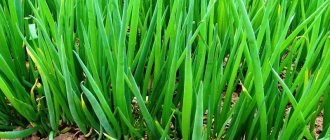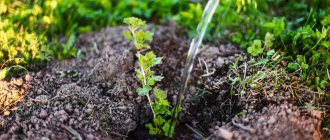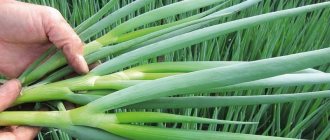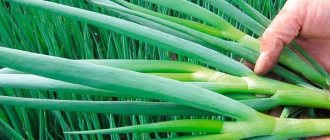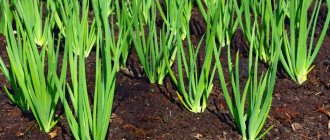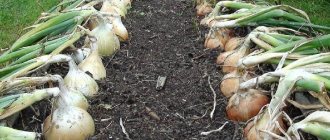Every person needs vitamins and nutrients. To compensate for their deficiency, you need to eat fresh greens. Greens stay in stores for a long time, so they lose their beneficial properties. It is best to grow greens on your own plot, but if you don’t have one, don’t be upset, as greens can grow on a balcony or windowsill. Parsley is considered the most useful herb, as it very quickly replenishes the lack of vitamins. The most common variety is root parsley, as it is the most delicious of all varieties of parsley.
Parsley root sugar. History of creation
Photo of parsley root sugar
Parsley originated in warm countries closer to the Mediterranean Sea, and then spread to Europe, this happened in the 9th century. Two centuries later, people began to plant it very often. But this was only for the treatment of various diseases. Parsley was called differently, and variegated grass, and sverbiga, and petrosyl grass.
It was not for nothing that this variety was called sugar, and this happened because of its interesting sweet taste. The variety also has a pleasant aroma. The root system of parsley is pure white, the root length is average, about 25 centimeters.
Uses of parsley
All over the world it is common to use parsley as a spice. It is added to:
- fish dishes;
- side dishes;
- meat dishes;
- soups.
When crushed, they are added to stews and many different sauces. The plant is also used in various dishes raw, fried and baked.
Soups with the addition of root parsley are tasty and aromatic
Each parsley bush contains flavonoids, essential oils, pectin and many other useful components. Regular consumption of this culture will help:
- stabilize intestinal function;
- increase immunity;
- get rid of kidney stones;
- cure gum disease.
When used externally, the root vegetable helps get rid of acne, blackheads, and oily shine.
We offer two ways to prepare parsley root - for internal and external use.
- To prepare a medicinal decoction , you need to pour 1 tbsp. a spoonful of finely chopped parsley root in 100 ml of boiling water. Boil for about 3 minutes. The resulting composition should be infused, after which it should be drunk three times a day before meals.
- The mixture for problem skin is prepared from 1 tbsp. spoons of grated parsley root, a small amount of black clay and 50 ml of water. The composition is used as a mask twice a week.
Girls whose hair is severely damaged by curling or frequent dyeing can use parsley decoction as a rinse. To do this, 2 roots are crushed and boiled in a liter of water for 15 minutes. The resulting decoction is infused and the hair is rinsed with it after washing.
Root parsley can be used for medicinal and preventive purposes
You can grow root sugar parsley in any convenient way and anywhere. This is a simple but interesting process, the result of which will be very healthy root vegetables and juicy greens. During the growing process, it is important to follow the main rules of gardeners so that the resulting harvest will please you.
When to plant root parsley with seeds
For a good harvest, you need to take care of parsley, plant it correctly and perform high-quality care. Otherwise, the harvest will be minimal and the plant will be susceptible to various diseases and pests.
First you need to decide what time to plant this variety.
You can start sowing parsley after the snow melts . You just need to wait until the soil warms up to at least +6 degrees. This applies to planting in open ground. A few days after the snow melts, air and soil temperatures quickly recover and warm up.
But you should not delay planting, since at high soil temperatures, water will begin to evaporate from it. And in such soil the seeds will not grow, so you need to monitor this moment.
When to plant root parsley before winter?
Root parsley is planted in open ground 15 days before frost appears. During this period, the seeds become swollen, but do not germinate. And with the onset of spring they will be ready to emerge.
Note: If you plant parsley seeds before frost, then you need to sow more seeds than planned, as some seeds may not sprout when spring begins.
If root parsley is planted at home, then the time of year does not matter.
Varieties and varieties
Leafy
This variety of parsley is grown for its fragrant and tender greens. Popular varieties:
- “Ordinary leaf” - forms a large rosette with a large number of dark green leaves (30–100 pieces), suitable for sowing before winter.
- "Breeze" is a frost-resistant variety. Greens are cut 80 days after germination. The rosette grows up to 75 cm in height.
- “Bogatyr” is a shade-tolerant variety with a late set of greenery. After cutting, it quickly grows a new one.
- "Astra" is an early variety with curly leaves. The green mass actively grows after cutting. Seeds can be sown before winter.
- “Esmeralda” is a curly-leaved variety with medium ripeness, forms a rosette with leaves on short petioles.
Root
This species uses roots and tops for food. It does not have many leaves, they are tougher and less aromatic compared to leafy greens.
If the leaves of root parsley are frequently torn off, the root stops growing. He remains frail and small.
Varieties:
- “Bordovikskaya” is a late-ripening variety with a cylindrical white root crop. The rosette has 28–30 dark green matte leaves.
- “Saharnaya” is an early ripening variety. The cone-shaped root vegetable of a grayish-white color is ready for consumption 95–100 days after the appearance of the first shoots. There are 20–40 leaves in the rosette. Not suitable for long-term storage.
- “Urozhaynaya” is a mid-season variety, ripeness occurs after 130 days. There are 11–20 leaves in a spreading leaf rosette. The length of the root crop is 20 cm, has good keeping quality.
Selecting a location
What does root parsley look like?
Choosing a location is a fairly important step when growing parsley. And it must meet certain criteria. Soil that is well loosened works well, as it conducts oxygen to the root system. The best options would be soddy-podzolic, super sandy and moderate loamy soil.
The place where the parsley will grow should be well lit by sunlight. If there is any shading, the branches will develop poorly. And as a result, the parsley will be small in size and lose its sweetness in taste.
A heated place is not suitable for parsley. Since such microflora very often becomes infected with fungus and rot. With high moisture and dampness, the root system of the soil begins to slowly rot, spreading to all the roots. And in this case the plant dies.
The landing site must be protected from strong winds and drafts. It would be good if there was a small building next to the place that would limit the plant from the winds, but not block it from the sun's rays.
Plants that grew earlier also greatly influence the development of parsley. If carrots or celery grew in this place, then such a place is not suitable. When growing the remaining crops, the parsley will develop perfectly.
Note: The site for planting must be prepared before planting. When planting in spring, you need to prepare the soil in autumn. If planting is carried out in winter, then 40 days before planting.
Boarding time
You need to choose a place in the fall. It is important to prepare the soil: dig up the ground (20-25 cm) and add humus to it (5 kg per 1 sq. m). You can plant parsley at the end of April; the plant germinates at a temperature of 3-4 C.
Root parsley is sensitive to sowing dates, so it is important to carry out spring planting before mid-May.
How to choose the right place? The place must be protected from drafts and at the same time sufficiently sunny, otherwise the plant will grow small. Parsley loves fertile soil ; under no circumstances should it be planted in clayey or heavy soil.
Plant it as a second crop; if you plant it first, the parsley will tend to branch. When choosing a location, keep in mind that the plant does not like carrots, coriander or dill already growing in this soil (what plants are compatible with parsley?).
Preparation of planting material
Before planting, you need to prepare the seeds so that their development occurs faster, without any slowdowns. Experienced vegetable growers know that there are many methods for activating active plant growth.
But the most effective and common way is the following method. Preparation of planting material should be carried out 20-25 days before planting. To process, place the seeds in warm water and leave for 14 days. Every day the water is changed 2-3 times. During this time they will have time to swell.
After 14 days, the seeds should be removed and rinsed well with clean water, then put in a bandage or gauze. In such conditions they will germinate well. The gauze or bandage should be placed in a warm place, above room temperature.
After 3-5 days, small sprouts will appear from the seeds, which are transferred to clean gauze and placed in the refrigerator. The sprouts stay in the refrigerator for 5-10 days. Then they are well dried and planted. To check whether they can be planted, the seeds must be combined together. If they are not sticky and loose, then planting can be carried out.
Care
If planting methods differ, then care is the same for any option and includes timely watering, fertilizing and other measures.
Thinning
The procedure is carried out for the first time when real leaves appear on young plants.:
- Remove the sprouts, leaving at least 3 cm of free space between them.
- Weak, damaged specimens are pulled out.
The second thinning will finally prepare the parsley for further full growth. It is carried out when 5-6 true leaves appear, and a distance between plants of 5-7 cm is achieved.
Watering
Root parsley is a moisture-loving crop, so the top layer of soil should not be allowed to dry out. Excessive accumulation of moisture is also undesirable, so water the plants as needed. The best time for this is morning or evening hours, the depth of the strait is at least 15 cm deep. The water must be settled in large containers , poured in advance in order to warm it up in the sun.
Loosening and mulching
The top layer of soil must be loosened after heavy rains to a depth of 5-6 cm, the day after watering. The hard crust is broken between the rows without affecting the near-root zone. Dry watering - loosening the soil is carried out regularly in a greenhouse and when growing crops at home on a windowsill - this will ensure a flow of oxygen to the roots and prevent the appearance of rot.
After sowing the seeds, the beds are mulched with a thin layer of peat or rotted manure. Be sure to remove weeds, especially in the first weeks after germination. Hilling of parsley is carried out when the above-ground part exceeds 10-12 cm .
Fertilizer
Parsley is fed after each thinning, using universal fertilizers that contain nitrogen, potassium, and phosphorus. 30 g of the complex preparation is dissolved in 10 liters of water and the beds are watered.
Growing root parsley in open ground: site preparation
When planting in fresh air, the place must be well prepared. Preparation consists, firstly, of applying fertilizer to the soil so that it becomes more fertile. Usually the planting site has poor soil, so applying fertilizer is necessary for a good harvest in the future.
Fertilizing can be done either in spring or autumn. In the spring, the bed should be fertilized with phosphorus fertilizers, about 60 grams per 1 square meter. Wood ash can be added to phosphorus fertilizer in an amount of 200 grams per 1 square meter. Wood ash fertilizes the soil, increasing its potassium content.
In autumn, the area must be fertilized using organic fertilizers, for example, humus. After applying fertilizer, you need to dig up the soil well so that everything is absorbed. On average, about 4 kilograms per 1 square meter are applied. But in order to get the best effect, you can add wood ash.
Diseases and pests
Pests of parsley are few. Basic:
- celery fly - destroyed by treatment with wood ash;
- carrot psyllid - afraid of tobacco dust;
- umbrella moth - dies when treated with a strong soap or pepper solution.
Diseases appear due to non-compliance with growing technologies. Black rot and powdery mildew attack due to high humidity. Disinfection of soil and seeds with Bordeaux mixture will save you from rust and septoria.
Root crops will not be branched if you use only rotted organic fertilizers to apply to the ground. To obtain early greenery in the spring, leave several root crops in the ground during the winter, sprinkled with peat. The unpretentiousness of Sugar parsley will allow even an inexperienced gardener to grow a rich harvest. Compliance with the basic rules is already the key to a good result.
Planting root sugar parsley: growing from seeds
Root parsley can be planted in a variety of ways. There are 4 planting methods that will be discussed. The planting method will depend on where you are growing it, in open ground or at home.
- Growing root parsley through seedlings. Is it possible to replant root parsley?
Gardeners do not like this method and consider it incorrect, since root parsley is a fragile and delicate plant that cannot recover after transplanting into open ground. This is true. Parsley has a very sensitive root system that does not tolerate sudden changes in temperature.
But at the same time, replanting root parsley, which will not damage the root system, is possible. To implement this, it is necessary to transport the parsley with the roots, which are located in an earthen coma, which will protect it from damage.
If you choose this planting method, please note that the planting material should be planted in mid-March. Any container is used for planting seedlings. But it should be wide and low. Nutrient soil is poured into this container. Then the root parsley is sown, and it is imperative to cover the soil with film to retain heat there.
A good temperature for seedlings is around +24 degrees. The soil must be moist and not dry for the sprout to develop well. When the first leaves appear, you need to gradually lower the temperature, first to +18 degrees. Transplantation of seedlings is carried out in the second half of May.
- The second method is to sow root parsley seeds directly in fresh air.
When planting this way, it must be taken into account that before planting, no fertilizing or fertilizer should be applied. Planting will be done in pre-prepared rows. The distance between them should be about 18-22 centimeters, and the depth is about 1.5 centimeters.
Planting material is planted several pieces in one hole. In this case, there should be about 5 centimeters between the pits. If you plant root parsley seeds in the spring, then after planting you need to water the ground with potassium humate. After planting, you need to fill in the seeds of root parsley and thoroughly compact the soil. This will keep the soil warm and moist. After compacting, you need to cover the soil with film.
In such a situation, the process of seed germination will be quite long. Therefore, you should not worry that there are no sprouts for a long time. In order for the sprouts to germinate faster, they need to be watered and done regularly.
After the sprouts appear, thinning must be done so that the parsley develops and grows faster. Only strong shoots should be left.
- How to plant root parsley at home
A lot of people love parsley. It is useful to add to various dishes. And in order to eat only healthy greens, you can grow them at home. Parsley will take up very little space and be located on the balcony or windowsill.
Moreover, greens can grow in winter, when there is a shortage of greens even in stores.
To plant, you will need low and wide containers or boxes. You need to fill the container with nutrient soil and make grooves. There should be a distance of 7 centimeters between them, and about 4 centimeters between the pits.
After planting is completed, the planting material is covered with earth, compacted and covered with film.
The fourth method is to plant germinated seeds
Usually only gardeners who don’t like to tolerate planting plant this way. This method makes the germination of parsley a faster process and also reduces the ripening time of the plant. Before planting, you need to germinate the seeds. To do this, they need to be filled with water with potassium permanganate and left for 24 hours. After which the seeds of the root parsley are removed and laid out on gauze.
Root parsley. What must be observed when landing?
Very important criteria are air temperature . First you need to ensure a temperature of about +12 degrees. And when small sprouts appear, you need to increase the temperature to +18 degrees.
The next important criterion will be watering . The soil should always be moist. Therefore, you need to water by spraying every time you notice a slight drying. Only excess moisture will also have a bad effect on the plant. Due to increased humidity, the root system and sprout will begin to rot, and the plant will die.
Lighting also plays a big role in the development of the plant. If there is no sunlight, it must be provided by lamps.
feed the plant when planting. If there is even the slightest drying of parsley, the dry parts should be cut off and the root system should be fertilized with mineral fertilizer. If flower arrows appear from the parsley, they need to be cut off.
Differences between cultivation and leaf type
Root parsley produces a harvest only in the second year ; in the first season, aromatic greens are eaten. In order not to be disappointed with the result, choose the type of plant that is most suitable for the chosen application.
How to choose a variety?
Late varieties with large, long roots are suitable for long-term storage, while early parsley with short, shortened roots is better for drying. Characteristics of varieties:
| Variety name | Ripening time | Features of the root vegetable | Application |
| Sugar | Early 95-100 days |
| Salads and canning. |
| Harvest | Mid-season 130 days |
|
|
| Berlin | Late ripening 150 days |
|
|
| Bordovikskaya | Late ripening 135 days |
|
|
| The final | Mid-season 130 days |
|
|
| Alba | Mid-season 120 days |
|
|
Parsley of the Sugar variety has become widespread and has won the special love of summer residents due to its characteristics. Its properties:
- unpretentiousness;
- precocity;
- resistance to low temperatures;
- tender, juicy root pulp;
- does not crack;
- greens with high taste;
- Possibility of growing in the garden, on the windowsill of the house.
The variety was bred in 1950, and over its long history has gained many fans. The only disadvantage is the impossibility of long-term storage of root vegetables, but there are many more advantages.
Seed cost
It is easy to buy planting material in any store or on the website of trading companies that provide fast delivery. The price of one bag of seeds weighing 2-3 g varies from 10 to 15 rubles . This packaging allows you to purchase 1000-1500 seeds in one package.
Root parsley: plant care
Caring for root parsley involves watering, thinning, fertilizing, treating diseases and preventive measures.
Watering
Watering must be regular and plentiful for good functioning. The best choice is to water at the same time. The plant develops well only with constantly moist soil. This is very important for parsley.
Only when watering, make sure that the moisture does not touch the rosette of foliage. During a hot period or during a period of active root growth, the amount of liquid added to the soil should increase. On average, about 18 liters per 1 square meter are used.
Implementation of thinning
When thinning, you should only get rid of weak and flaccid shoots. Strong and healthy shoots should remain on the ridge. After all, this is the only way they will develop well and produce a good harvest in the future.
Thinning should be done for the first time after the sprouts appear. Between each crop you need to leave about 2.5 centimeters. The next thinning should be carried out 2 weeks after the first. It is during this thinning that strong plants can be identified, which are left. With this thinning, the distance between plants increases to 7 centimeters.
Soil cleaning
The soil must be promptly cleared of weeds and various debris that is in the soil. The first cleaning should be carried out to a depth of 4-5 centimeters. And the next cleaning will affect increasingly lower layers of soil, reaching up to 18 centimeters.
Along with harvesting, it is necessary to loosen the soil. Gardeners want to start loosening as early as possible, so they begin to add other seeds to the parsley planting material, which will act as beacons. That is, for 10 parsley seeds add 1-2 mustard or lettuce seeds.
These beacons are needed in order to find out when it is already possible to loosen. After these beacons sprout, you need to loosen the soil.
It is also necessary to loosen the soil after each watering or rain to ensure the supply of oxygen to the root system.
How to feed root parsley?
Feeding with various fertilizers is a very important stage in the care and cultivation of root parsley. When root parsley enters the growing season, it will especially need feeding. During this period, it is necessary to add a nitrogen and potassium mixture to the soil.
Fertilizer application is carried out in two stages. After 2-3 leaves have appeared, 20 grams of saltpeter must be added to the soil. And after 20 days you need to take 10 grams of saltpeter and 20 grams of phosphate and add them to the soil. Ammonium nitrate is very often used to ensure that plants take root well and produce a large harvest.
When to harvest root parsley?
Root parsley: photo
It is customary to collect root parsley at the end of September; by this time the root parsley is fully ripe. Although the collection depends only on the region where the parsley grows. In warm areas, full ripening occurs earlier than in cold areas.
Harvesting should only be done in good weather. It should be dry, sunny and without dew. Cleaning is done as follows:
- To begin with, cut off all the branches, but only so that the stump remains.
- The fruits are carefully pulled out of the soil. To make this process easier, the ground must be well loosened.
- The harvest should be placed in a sunny place so that they dry a little.
- After the crop is completely dry, you need to get rid of the soil and send it for storage, or proceed to consumption.
Time for truth: how to harvest parsley?
The most optimal time for harvesting parsley is the last ten days of September. However, the harvesting period may vary depending on the growing climate zone.
The weather for harvesting should be dry and sunny. The cleaning algorithm will be as follows:
- Cut off all the green branches so that only a small stump remains on the surface.
- Carefully remove the root vegetables from the ground. It is better to loosen the ground first so that they come out easier.
- I place the root vegetables in a lighted place to dry.
When all the moisture has evaporated, excess soil is removed from the roots and sent for storage. You can eat them immediately.
Harvest occurs in mid-autumn
What can cause root parsley diseases?
Root parsley has a fairly high resistance to various diseases and pests, but it can still develop some diseases.
- The most common disease is peronosporosis . When infected with it, the plant begins to be affected and becomes a white dot. These dots are becoming larger and larger every day, and also turn from white to yellow. To get rid of the disease, you need to cut off all the infected parts.
- The plant can also be attacked by carrot fly . This pest is very dangerous, as it begins to destroy the root system by eating it. The pest causes the plant to turn yellow and stops its growth. To cure parsley from a pest, you need to treat it with an infusion of orange peels or an infusion of garlic.
- Parsley often gets rust. With this disease, parsley turns orange speckled. Very often the pest attack occurs at the beginning of the summer period. Rust begins to spoil the fruits and the plant itself as a whole. Bordeaux mixture or copper oxychloride will help get rid of it.
- The last pest will be aphids. It often settles on plants and parsley is no exception. To recognize aphids, you need to conduct an inspection. And if you notice a limp and drying appearance of the plant, it should be treated immediately. After all, aphids begin to suck the juice from the parsley, depriving it of all nutrients. Using dandelion infusion will help get rid of aphids. To prepare the infusion, you need to use the foliage and root system of the plant, and warm water. All components are mixed and left for 4-5 hours.
Price and places of sale of seeds
You can buy seeds in Moscow and St. Petersburg both in stationary and online stores.
Stores and estimated prices for root parsley seeds:
| Sales points | Price range, rub. |
| semena-zakaz.ru | 4 – 10 |
| First seeds | 16 – 26 |
| The seeds are here | 4,8 – 16 |
| Seeds on Yablochkova | 16 – 23 |
Sugar root parsley: uses and benefits
Parsley is a popular herb around the world and is often used. How to use root parsley? It can be added to food to make the taste more interesting and refined.
Eating parsley provides a person with the nutrients he needs. The benefit of root parsley is that it can be used to make various infusions, decoctions and solutions that can be used for cosmetic or medicinal purposes.
Harvest and storage
The time to dig up parsley roots comes in early autumn. They are carefully lifted with a pitchfork. This tool causes the least damage to root crops.
The dug up plants are shaken off the ground and dried in the sun for 2 hours. This procedure destroys harmful bacteria.
Then the tops are cut off. If you plan to force greens from the root part in winter, leave a stump of 1-2 cm. When storing, cut off the growing point along with part of the root crop. This will keep the parsley juicy.
In the refrigerator, the roots are stored in a perforated plastic bag. Some gardeners cover the root crop with wet sand and lower it into the cellar.
Harvest parsley retains its taste and nutrients when frozen. The roots should be washed, chopped and placed in a container or bag. The root herb tastes great in the freezer, making the roots ready to use throughout the year.
Estimated prices for seed material
| Point of sale | Eagle, rub/g | Spicy, rub/g | Doctor, rub/g | Sugar, rub/g | Good morning, RUR/g | Konika, rub/g | Berlinskaya, rub/y |
| Agro – SOS | 588/ 50 g | — | — | 306/500 g | — | — | — |
| SEEDSPOST.ru | 35/0.5 g | 15/3 g | — | 25/2 g | — | — | 15/2 g |
| The seeds are here | 11.4/0.5 g | 9/2 g | 5.1/2 g | 5.1/2 g | 5.1/2 g | — | — |
| Semenapost.ru | 35/0.5 g | 15/3 g | — | 25/2 g | — | 45/5 g | 15/2 g |
Application area
Parsley root may have some beneficial effects on the human body:
- choleretic (bile liquefies, which promotes its outflow);
- anti-inflammatory (disinfection of wounds);
- carminative (normalization of intestinal function);
- tonic (energy is added, the functioning of the nervous system is normalized);
- diuretic (bringing blood pressure to normal levels by removing excess moisture from the body).
Thus, with the systematic use of root parsley, the functioning of the whole organism is improved, and especially:
- urinary system;
- cardiovascular;
- nervous;
- gastrointestinal tract.
Root parsley should be limited in use for epilepsy, diseases of the gastrointestinal tract, pregnancy, individual intolerance, as well as for children under one year of age.
More information about the benefits and harms of root parsley, as well as its use for medicinal purposes, is described in this article.
